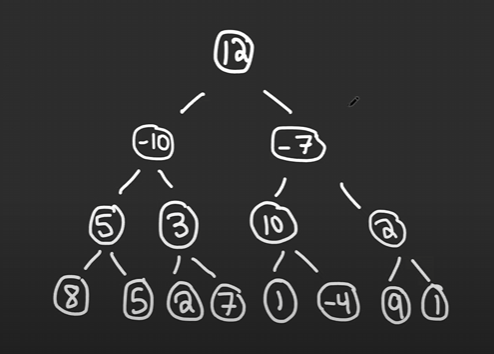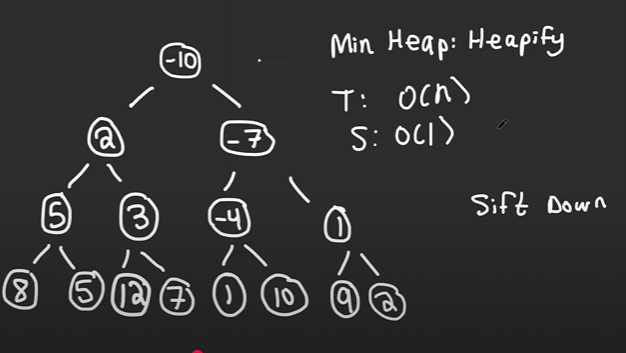Class: Leetcode Subject: computer-science heaps leetcode Date: 2025-08-15 Teacher: **Gregg Hogg
Heaps/Priority Queues
Operations
1. Heap pop()
- takes out a value from the heap Time Complexity :
2. Heap push()
- pushes a value onto the heap Time Complexity :
3. Heap peak()
- gets the smallest value from the heap Time Complexity :
4. Heapify()
- this initializes the heap. It’s a custom python data structure
Min Heap: Example

-
This is currently a binary tree
-
We’ll call heapify on it to turn it into a min heap
- This will sift down the tree. Essentially it will look at the right most, non-leaf node(2) and check if it’s left or right are smaller. If it is, it will swap with the 2 and so on.
-
The final min heap will look something like this:

Time Complexity : Space Complexity :
Max Heap: Example
- it’s the exact same for min heap except it replaces with the larger value
Building a Min Heap
Min Heap
A = [-4, 3, 1, 0, 2, 5, 10, 8, 12, 9]
import heapq
heapq.heapify(A)
print(A) # [-4, 0, 1, 3, 2, 5, 10, 8, 12, 9]Push()
# Heap Push (Insert element)
# Time: O(log n)
heapq.heappush(A, 4)
print(A) # [-4, 0, 1, 3, 2, 5, 10, 8, 12, 9, 4]Pop()
# Heap Pop (Extract min)
# Time: O(log n)
minn = heapq.heappop(A)
print(A, minn) # ([0, 2, 1, 3, 4, 5, 10, 8, 12, 9], -4)Heap Sort
# Heap Sort
# Time O(n log n)
# Space O(n)
# Note: O(1) Space is possible via swapping, but this is complex
def heapsort(arr):
heapq.heapify(arr)
n = len(arr)
res = [0] * n
for i in range(n):
minn = heapq.heappop(arr) # this will get the smallest element
res[i] = minn
return res
heapsort([1, 3, 5, 7, 9, 2, 4, 6, 8, 0]) # [0, 1, 2, 3, 4, 5, 6, 7, 8, 9]